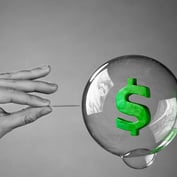What are financial advisors to make of Bitcoin? A quick Google search reveals descriptions of Bitcoin ranging from “scam,” “speculative bubble,” “investment mania,” and “money laundering scheme,” to “the currency of the future.”
On a more factual basis, here’s what we do know about Bitcoin: It opened on Aug. 11, 2010 at $0.06 per coin. By Dec. 11, 2017, Bitcoins were selling for $17,549.66. As of Jan. 9, 2018, they were trading at $14,789.
Do these prices make Bitcoin a speculative bubble? That is, a market in which investors are paying increasingly higher prices based solely on the belief that other investors will pay even higher prices. Considering that Bitcoin itself has no inherent value, it’s easy to see why some folks believe the Bitcoin market is pure speculation.
(While some Bitcoin advocates are quick to point out that the same could be said of U.S. paper money, they overlook the fact that sellers are required by law to accept U.S. dollars, regardless of the value of the paper they are printed on.)
I find it ironic that the Bitcoin market emerged less than 10 years after the last speculative market crash in 2001, when the dot-com stock bubble burst, and the Nasdaq fell some 52% to 1,950 from 4,069.
A popular joke that captured the speculative mania of that time went like this. One tech investor ran into another tech investor walking his dog on Nob Hill in San Francisco. The dog walker asked: “What do you think of my new $1 million dog?” The other investor replied: “That’s ridiculous. That dog isn’t worth $1 million.” “Sure he is,” the other investor replied. “I traded two $500,000 cats for him.”
The not so funny truth is that many, if not most, of today’s Bitcoin “investors,” aren’t old enough to have a clear memory of the dot-com market, nor are they likely to have read much about the history of other speculative investment markets, either.








 January 29, 2018 at 07:00 PM
January 29, 2018 at 07:00 PM










